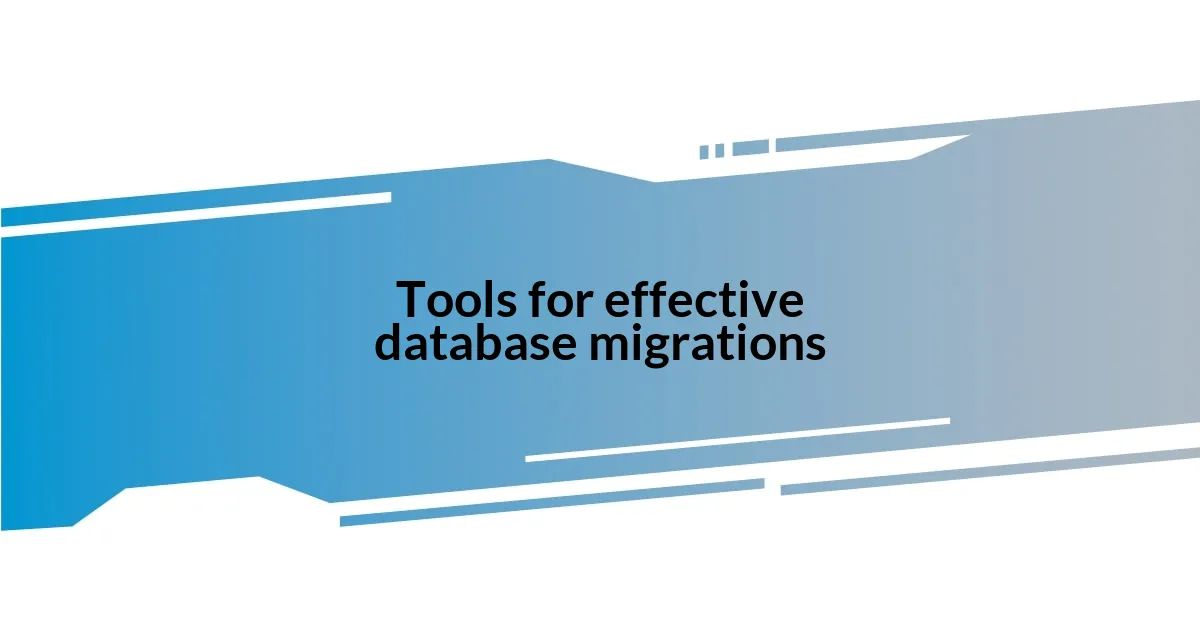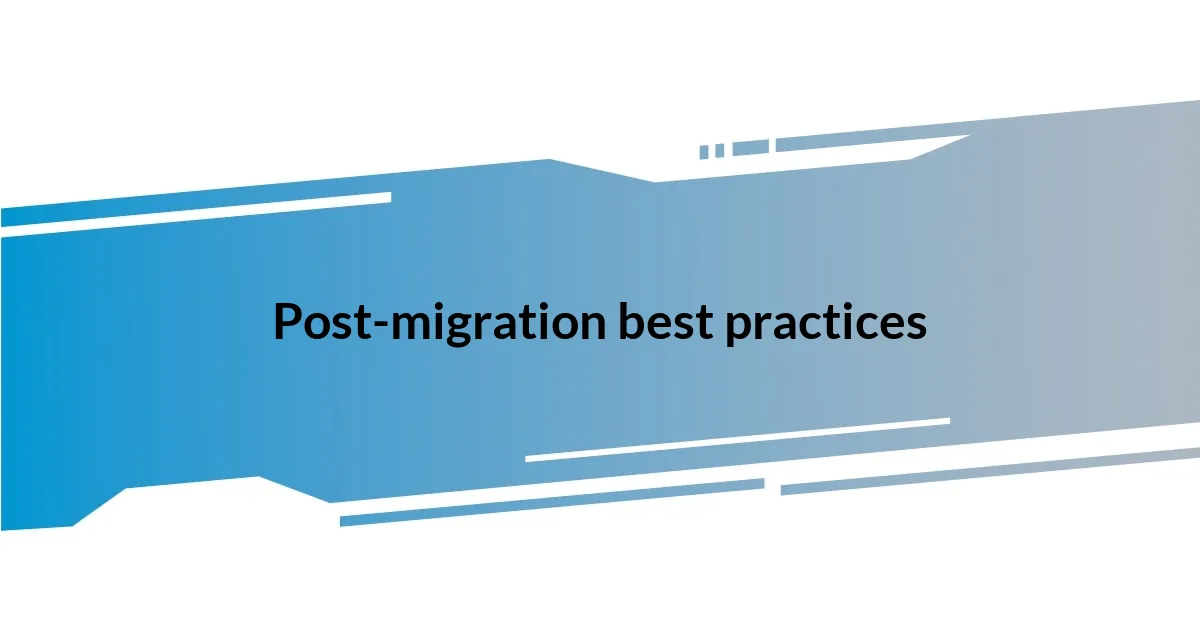Key takeaways:
- Database migration involves careful planning, detailed documentation, and clear communication to avoid potential pitfalls and ensure a smooth transition.
- Thorough testing and validation, including creating a sandbox environment, are essential to catch errors before they impact the live system.
- Establishing a rollback strategy prepares teams for unexpected issues, allowing quick recovery if problems arise during or after migration.
- Post-migration practices, such as data validation and team debriefings, are crucial for maintaining data integrity and improving future migration efforts.

Understanding database migration
Database migration can often feel like navigating a maze, with countless decisions to make and potential pitfalls lurking at every corner. I remember the first time I faced a migration; there was a mix of excitement and dread. What if something went wrong? This uncertainty is common among those who are venturing into migration for the first time.
Understanding the nuances of database migration is crucial. It’s more than just copying data; it involves transferring schema, optimizing performance, and ensuring data integrity. I’ve found that mapping out each step beforehand makes a huge difference. Have you ever tried migrating data without a clear plan? The chaos can be overwhelming, leading to frustrating days spent troubleshooting issues that could have been avoided.
A successful migration depends heavily on thorough testing and validation. I once underestimated this step, thinking I could just wing it, and ended up spending countless hours fixing errors that a few test runs could have caught. My advice? Don’t skip the testing phase—it’s your best ally in ensuring a smooth transition.

Key principles of successful migrations
Successful database migrations rely on a few core principles that can’t be overlooked. First and foremost, clear documentation is essential. I still recall a migration project where lacking solid documentation led to a lot of confusion among team members. Everyone was attempting to remember individual configurations, and that’s when mistakes started creeping in. Just imagine the frustration when I discovered discrepancies in schema conversions that could have been easily avoided with a well-documented process.
Another critical principle is communication. I once worked on a migration alongside a team offshore, and the differences in time zones created gaps in understanding what had been done versus what was planned. We missed several key updates because one group assumed the other was on the same page. Regular check-ins and updates can keep everyone aligned and minimize surprises. Think about it—wouldn’t it feel reassuring to know that everyone is working toward the same goal with full awareness of the current status?
Finally, having a robust rollback strategy is vital. I learned the hard way that it’s not merely about moving forward; it’s also about being prepared to step back if things go sideways. On one occasion, we faced unexpected data inconsistencies just after going live. Because we had a rollback plan ready, we managed to revert to a stable state quickly. It was a breath of fresh air to know we had a safety net—never underestimate the power of being prepared for the unforeseen.
| Principle | Description |
|---|---|
| Documentation | Ensures clarity and reduces confusion during the migration process. |
| Communication | Regular updates keep team members aligned and informed on progress. |
| Rollback Strategy | A prepared plan to revert changes in case of unexpected issues. |

Planning your migration strategy
When I reflect on planning a migration strategy, I realize that establishing a clear and well-structured approach saves so much stress in the long run. The very first migration I handled felt like preparing for a trip without a map—I was excited yet anxious. I learned that breaking down the migration into smaller, manageable milestones can lead to significant confidence boosts. It’s like celebrating small wins along the way; each completed task reassures you that you’re on the right path.
Here are some key elements to consider when planning your migration strategy:
– Assess Your Current Environment: Understand what you’re working with, including existing data structures and potential compatibility issues.
– Define Migration Objectives: Outline what you want to achieve with the migration and how success will be measured.
– Create a Timeline: A realistic schedule helps set expectations and ensures accountability throughout the process.
– Stakeholder Involvement: Engage team members and decision-makers early to gather insights and foster a sense of ownership.
– Backup Data: Always have a reliable backup before starting; this step can save you from unwanted surprises.
I remember when we were planning our last migration; an unexpected stakeholder brought up concerns that initially seemed minor, but they turned out to be pivotal. By integrating their perspective into our strategy, we enhanced our approach and managed to navigate potential roadblocks. It was a powerful reminder of how inclusive planning can elevate the overall success of a project, highlighting the importance of collaboration.

Tools for effective database migrations
When it comes to tools for effective database migrations, I’m a big fan of using migration automation software. Tools like Liquibase and Flyway have transformed how I handle schema changes and data migrations. For instance, I remember the first time I used Liquibase; it felt like I jumped from driving a manual car to cruising in an automatic. The way it helped me manage changes in a systematic way—applying them with a simple command—was a game changer. It’s amazing how a good tool can take the edge off the complicated process of migration.
Another must-have is a reliable backup solution. On one occasion, during a migration to a new database system, I relied heavily on my backup tool for an unexpected rollback. Without it, I would have been faced with frantic data recovery efforts. The peace of mind that came from knowing my data was secure was priceless. So, I always ask: how prepared are you for the unexpected? Investing in a solid backup tool is non-negotiable for every migration.
Version control systems also play a crucial role in managing database changes. I’ve found that pairing tools like Git with migration scripts keeps everything organized and straightforward. Just imagine how handy it is to track changes across iterations! When I worked on a particularly complex project with multiple branches, having version control allowed us to pinpoint exactly where things went wrong and to fix them quickly. It’s not just about managing data; it’s about managing the process better. It makes me wonder: wouldn’t you feel more at ease knowing you have a handle on every stage of your migration?

Testing the migration process
When testing the migration process, I can’t stress enough how important it is to create a sandbox environment. Creating a replica of your production database allows you to thoroughly test every aspect of the migration without any real-world consequences. I recall a time when I skipped this step and found myself scrambling to fix critical errors post-migration. It was a stressful experience that taught me the value of careful preparation.
Another crucial element is scripting the tests. Automated tests can save you hours of manual checking. I remember developing a suite of tests that included not only data integrity checks but also performance benchmarks. The sense of assurance I felt as my scripts confirmed that everything was functioning smoothly was priceless. It really made me question how often we take shortcuts in our processes—what could we be overlooking?
Finally, I’ve learned to gather feedback from team members involved in the testing phase. Their insights can highlight issues that I might not have considered. Once, a colleague pointed out a subtle but critical data discrepancy that had flown under the radar during my initial checks. Engaging your team during testing fosters a more comprehensive understanding of the migration’s success, making me wonder: how often do we utilize collaboration to reinforce our testing processes?

Common challenges and solutions
Common challenges during database migrations often revolve around data integrity and system compatibility. I recall feeling a sense of dread when migrating between different database systems, as I knew discrepancies in data formats could arise. During one migration, I faced a frustrating issue where certain data types simply didn’t align, leading to a cascade of errors. It made me realize how crucial it is to thoroughly map out and understand the data schemas before diving into the migration.
Another common hurdle is the downtime associated with migrations. I once managed a migration where downtime was critically unacceptable for the business. To tackle this, we employed a phased approach, moving non-essential data first while keeping the main system operational. This not only minimized disruption but also highlighted the importance of planning around business needs. Have you considered how downtime impacts your users and what strategies you might use to mitigate it?
Lastly, monitoring post-migration can easily get overlooked amid the excitement of completion. I remember feeling a mix of relief and apprehension right after a recent migration went live. To be safe, I set up monitoring alerts to track performance and errors closely, finding comfort in the ability to intervene quickly if something went awry. It’s essential to adopt a proactive mindset—how often do we reflect on what happens after the migration finishes? Establishing monitoring protocols can make all the difference in ensuring long-term success.

Post-migration best practices
One best practice I always recommend after a migration is to conduct a comprehensive data validation. I once overlooked this step, assuming everything was perfectly in place. It turned out some records had discrepancies that needed to be addressed immediately. The realization that small oversights could lead to significant data issues was a real eye-opener for me. Have you taken the time to ensure that your data matches your expectations?
Another key post-migration step is to update your documentation and workflows. I vividly remember wrapping up a successful migration only to find my team struggling because our documentation was outdated. This created confusion and unnecessary frustration. By ensuring that everything is current—from database schemas to process flows—I can empower my team to adapt more smoothly. It begs the question: how often do we revisit and revise our documentation after major changes?
I can’t stress enough the importance of team debriefings post-migration. After one particularly challenging migration, we gathered to discuss what worked and what didn’t. This honestly felt cathartic, and the shared insights led to actionable improvements for future migrations. What if we made this a habit every time? Embracing a culture of continuous learning not only helps in refining our strategies but also fosters teamwork and camaraderie, ensuring that no one feels isolated in their challenges.